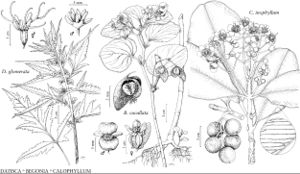Calophyllum
Sp. Pl. 1: 513. 1753.
Gen. Pl. ed. 5, 229. 1754.
| Taxon | Illustrator ⠉ | |
|---|---|---|
 | Begonia cucullata Calophyllum inophyllum Datisca glomerata | Linny Heagy Yevonn Wilson-Ramsey Linny Heagy |
Trees [shrubs], hairy at least on buds, with stilt or loop roots. Stems ± flattened and angled when young. Leaves: petiole concave, without adaxial protuberance; blade coriaceous, venation close, apparently unbranched, parallel, uniting to form marginal or submarginal vein and alternating with and usually more prominent than latex canals, without tertiary venation visible between lateral-veins. Inflorescences racemiform; peduncle and rachis usually present; bracts usually deciduous, small. Flowers bisexual; sepals deciduous, 4, distinct, in decussate pairs, outer 1–2 pairs rarely much different from rest; stamens obscurely 4-fascicled; style slender, ca. 4 times as long as ovary. Fruits drupaceous; pericarp firm or fleshy, smooth when fresh. Seeds 1. x = 16.
Distribution
Introduced; Fla., Mexico, West Indies, Central America, South America, Asia, Africa, Indian Ocean Islands (Madagascar), Pacific Islands
Discussion
Calophyllum includes about ten species in the American tropics, the rest in Asia, Africa, Madagascar, and the Pacific.
Species ca. 190 (1 in the flora).
Selected References
None.
Lower Taxa
"timesaslongasovary" is not declared as a valid unit of measurement for this property.